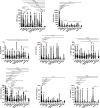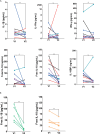Elevated serum levels of interleukin-18 discriminate Still's disease from other autoinflammatory conditions: results from the European ImmunAID cohort
- PMID: 40341183
- PMCID: PMC12060884
- DOI: 10.1136/rmdopen-2024-005388
Elevated serum levels of interleukin-18 discriminate Still's disease from other autoinflammatory conditions: results from the European ImmunAID cohort
Abstract
Objectives: Systemic autoinflammatory diseases (SAIDs) represent a set of conditions with exaggerated innate immune responses. IL-1β and IL-18 are key cytokines involved in the pathogenesis of some SAID. We aimed to assess the diagnostic value of serum levels of IL-1β, IL-18, their respective inhibitors IL-1Ra and IL-18 binding protein (IL-18BP), and IFN-γ in SAID.
Methods: A cohort of patients with active SAID, including monogenic (mSAID) and genetically undiagnosed SAID (guSAID) from different European countries, with active disease at inclusion, was established. Serum levels of cytokines were measured by immunoassays.
Results: Sera from 53 mSAID, 220 guSAID and 49 controls without inflammatory disease were analysed. Serum levels of total and free IL-18 were significantly increased in Still's disease in comparison to most SAID and non-inflammatory controls. Levels of total IL-18 were also elevated in patients with familial Mediterranean fever to a comparable extent as in Still's disease. In contrast, free IL-18 levels were selectively higher in Still's disease. Receiver operating characteristic curve analysis showed that total IL-18 was the most sensitive and specific marker for the diagnosis of Still's disease (area under the curve=0.91). There was a positive correlation between IL-18 and ferritin. In 10 patients with Still's disease who had a second blood collection, we found a significant decrease in serum levels of free IL-18 after treatment.
Conclusions: Our results show that IL-18 can discriminate Still's disease from other SAID, and free IL-18 levels may be relevant to assess response to therapy in these patients.
Keywords: Biomarkers; Cytokines; Inflammation; Still's Disease, Adult-Onset.
© Author(s) (or their employer(s)) 2025. Re-use permitted under CC BY-NC. No commercial re-use. See rights and permissions. Published by BMJ Group.
Conflict of interest statement
Competing interests: CG has received research funds and has shares from AB2 Bio, Lausanne, Switzerland.
Figures




References
MeSH terms
Substances
LinkOut - more resources
Full Text Sources
Miscellaneous
